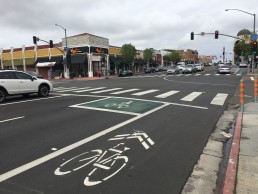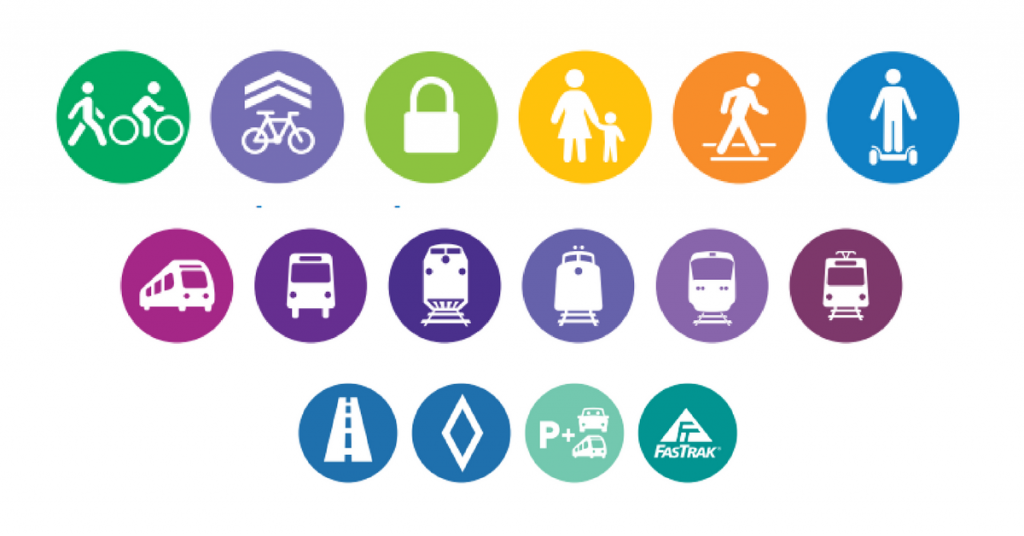Bike Infrastructure Explained: Bike Box

This post is the first in a series of posts that will explain and illustrate bicycle infrastructure designs. These are the designs we want to see on our streets. These are designs that provide solutions for rider safety and comfort. All of the infrastructure featured is from the NACTO Urban Bikeway Design Guide which “is based on the experience of the best cycling cities in the world.” And here at BikeSD we want San Diego to be one of the best cycling cities in the world! So let’s start with BIKE BOX.
What is a bike box? If you google bike box, you will see a shipping box, but that is not what we are talking about. A bike box is a designated area (generally painted green) at the head of a traffic lane at a signalized intersection (an intersection with a stop light or traffic light.) It provides bicyclists with a safe and visible way to get ahead of a line of traffic during the red signal phase (when the light is red.) Nearly all the benefits of a bike box are related to increased safety for riders. But, there are some benefits to motorized vehicles that come from using bike boxes.
Bike Box Benefits
A bike box increases VISIBILITY of people riding bicycles. There are things that riders do to make themselves visible such as wearing bright clothing and using flashing lights. Being visible is key to bicycling safety. A bike box on the street helps bicycles be more visible at intersections. The bright green painted box highlights a location and motorists can expect to see someone on a bicycle in that location.
A bike box decreases the chance of a RIGHT HOOK which is a leading cause of both car vs bicycle and car vs pedestrian crashes. A right hook dangerous crash that involves a vehicle turning right into the path of a pedestrian or a bicycle going straight. Bike boxes can help prevent this kind of crash because the bicycle rider is positioned at the front of motor vehicles at the intersection.
A bike box provides PRIORITY for bicyclists at signalized intersections of major streets. Groups of bicyclists together can clear an intersection quickly, minimizing impediment to transit or other traffic. This priority has benefits for motorized vehicles because the people on bicycles in the bike box clear the intersection more quickly than a line of bicycles so right turning traffic moves through the intersection more quickly.
Bike Boxes in San Diego

The intersection of University Ave and 6th Ave in Hillcrest has a bike box as part of the recently painted bike lanes. Cars are supposed to stop at the edge of the box, but have not yet learned how to use the infrastructure. Some bike boxes have WAIT HERE painted at the limit line of the box.
The new infrastructure on University Ave helps with comfort and safety. It is not perfect, but it is a start.
SANDAG 2019 Regional Plan Transportation Themes Open Houses
SANDAG is in the process of developing San Diego Forward: The 2019-2050 Regional Plan, which will outline the overarching vision for our region over the next 30 years. As part of this process, SANDAG is asking for your input on what you think the San Diego region’s transportation network should look like in the future and what transportation issues are most important for your quality of life. This survey is available through May 10.
TAKE THE SURVEY
You will have to write in BICYCLE many times on the survey questions. For example, to answer the question "What method(s) of transportation do you use during your daily commute? (Select all that apply.)," Walking and Biking are listed together under Active Transportation. Walking and Biking are transportation modes that use different infrastructure. Biking should be its own method of transportation, particularly with such an extensive list that, for example, separates Carpool and Vanpool and has separate categories for Bus and Rapid. There are three comment areas on the survey to comment and reiterate that bicycling is extremely important. Let’s make our voices heard.
There are several workshops scheduled, during which, SANDAG employees are available to answer questions at multiple poster stations. The graphics are highly engaging, but the content is generalized and informational and avoids serious discussions regarding Climate Action Plan or Vision Zero goals. Here is the schedule for the upcoming workshops:
North County Coastal: Wednesday, April 25 from 5:30-7:30 p.m. Encinitas Public Library Community Room | 540 Cornish Drive, Encinitas 92024
East County: Monday, April 30 from 3:30–5:30 p.m. El Cajon Police Department Community Room | 100 Civic Center Way, El Cajon 92020
South County: Tuesday, May 1 from 5–7 p.m. San Ysidro Civic Center | 212 W. Park Avenue, San Diego 92173
North County Inland: Wednesday, May 2 from 5–7 p.m. Centro Universidad Popular | 1234 N. Santa Fe Ave, Suite 100 Vista 92083
Central San Diego: Thursday, May 3 from 5:30–7:30 p.m. Jackie Robinson Family YMCA Community Room | 151 YMCA Way, San Diego 92102
CLICK HERE for supporting materials for the workshops.
I attended the last workshop and here are a some of my comments on the information stations:
Emerging Technologies
"Technology is evolving and has the potential to radically change our region’s transportation system." I am doubtful that technology will radically change the region’s transportation system away from a car-centric approach. Political will could radically change the system, but not technology. Additionally, there is some early research that indicates ride sharing services increase Vehicle Miles Traveled or VMT.
Regional Plan Overview
Overall the Transportation Themes lean heavily toward a continuing car-centric approach to transportation. The Regional Economic Prosperity Objective includes "investing in transportation projects that provide access for all communities to a variety of jobs with competitive wages." And the Policy Objectives for Environmental Stewardship include making "...transportation investments that result in cleaner air, environmental protection, conservation, efficiency, and sustainable living and address climate change." How do these two policies interact? How is success measured for these policies?
Climate Change and Environment
On the poster "Reducing Greenhouse Gas Emissions: Passenger Vehicles and Electricity," the regional plan calls for allocating funding to electric vehicle charging stations while the "Local Efforts" poster calls for promoting public transit access, active transportation, parking management, and complete streets.
What Do We Want to Promote?
What does “Promote” mean? I would like to see “allocate funding for public transit access, active transportation, and complete streets.” Throw out parking management which is a euphemism for “make parking easier”—which promotes driving.
Healthy Communities
This station explains all the benefits from Policies and Strategies if local jurisdictions invest in transportation infrastructure that maximizes public health benefits, social interaction, and community cohesion. The benefits are numerous for increased access to active transportation and public transit, and walkable and bikeable neighborhoods.
Performance Measures
"Performance Measures" are a series of questions in several categories. For example, "Innovative Mobility & Planning Goals" includes these three questions:
1. Is delay reduced?
2. Are more people walking, biking, using transit, and sharing rides?
3. Is the transportation system safer?
These are great questions, the key is how will they translate into performance measures? And how much money will be allocated to measuring the goals?
Please attend a workshop in your region or take the online survey and type BIKES!


